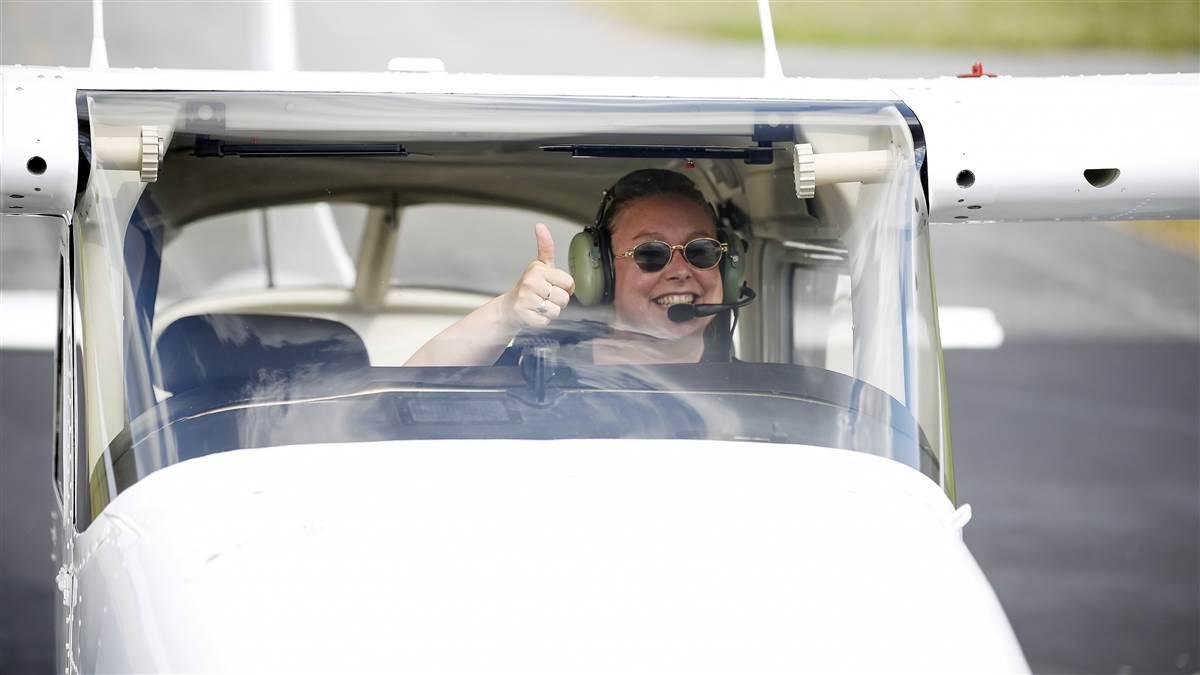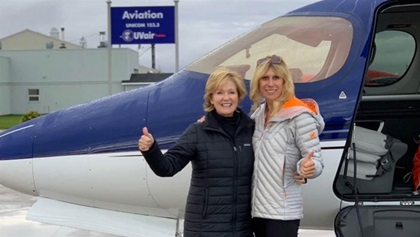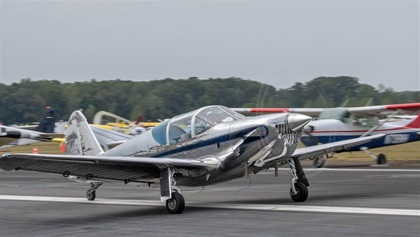Terrific time in Tennessee
Tullahoma Fly-In ends a year of celebration
AOPA has postponed its San Marcos and Casper fly-ins. Click here for more details.
A caption on this page incorrectly identified Christin Sanders as a competitor in the short takeoff and landing competition at the Stihl National Championship< Air Races. She was an attendee, not a competitor. AOPA regrets the error.
By Mike Collins

AOPA wrapped up its eightieth anniversary celebration September 13 and 14 with a return to a favorite location, holding its third and final 2019 fly-in at Tullahoma Regional Airport/William Northern Field in Tullahoma, Tennessee. Although the weather was hot, attendance was even hotter. Friday saw 3,536 guests, with 5,889 visitors on Saturday, for a two-day total of 9,425. The advisory airboss and airside volunteers handled 572 aircraft.
AOPA had visited Tullahoma before, for its final 2015 fly-in, which got off to a drenching start but the weather improved enough to tally 2,500 people and more than 330 aircraft.
The Beechcraft Heritage Museum, located on the Tullahoma airport, was a popular stop for fly-in visitors. It began as the Staggerwing Museum Foundation in 1973, and in 2007 expanded to include the full Beechcraft lineage. Joey Gray of Decatur, Alabama, visited the museum for the first time in 30 years and said that a lot had changed. His favorite exhibit was a mostly uncovered Staggerwing, exposing the structure of the fuselage and wings. “You don’t see that many Staggerwings around these days, much less the inside of one.”
Friday evening and Saturday afternoon saw the third STOL demonstration of the year with many aircraft participating, including AOPA President Mark Baker in his Super Cub. Wrangler Jimmy Gist masterfully manned the demonstration.
Dennis Harrington and Keane Brown each received a Lightspeed Zulu 3 headset, one at each of the fly-in’s two AOPA Pilot Town Halls, for flying the farthest distance to Tullahoma. Harrington and Brown each flew from New Mexico, where it turns out they’re based about 100 miles apart.
“Tullahoma once again exceeded our expectations,” said Chris Eads, AOPA senior director of outreach and events. “We are hard at work selecting our locations for next year and anticipating another great AOPA Fly-In season.”
AOPA expects to announce its 2020 Fly-In schedule later this year.
Email [email protected]
Lighting up the sky
 Drones lit the night sky over Tullahoma on September 13, delivering on a promise to celebrate AOPA’s eightieth anniversary with a custom show. Bad weather in Frederick, Maryland, had grounded the Great Lakes Drone Company fleet of LED-toting unmanned aircraft. Trouble with the custom software forced a fleetwide overhaul that nixed the show in Livermore, California, in June. But the persistence of the Great Lakes Drone Company team paid off in Tullahoma, where more than 60 drones flew in digitally choreographed formations set to music, creating airplanes and other shapes with points of light in the night sky. The crowd clearly enjoyed the show. They had a chance to see the power of the emerging technology to entertain—just one of the hundreds of missions that drones are accomplishing or poised to achieve as integration proceeds in the years to come.
Drones lit the night sky over Tullahoma on September 13, delivering on a promise to celebrate AOPA’s eightieth anniversary with a custom show. Bad weather in Frederick, Maryland, had grounded the Great Lakes Drone Company fleet of LED-toting unmanned aircraft. Trouble with the custom software forced a fleetwide overhaul that nixed the show in Livermore, California, in June. But the persistence of the Great Lakes Drone Company team paid off in Tullahoma, where more than 60 drones flew in digitally choreographed formations set to music, creating airplanes and other shapes with points of light in the night sky. The crowd clearly enjoyed the show. They had a chance to see the power of the emerging technology to entertain—just one of the hundreds of missions that drones are accomplishing or poised to achieve as integration proceeds in the years to come.

Air Safety Institute
Beyond the checkride
Proficiency with purpose
By Alicia Herron
There are a couple of landmark flights on the journey to a private pilot certificate, most notably the first solo and the checkride. After the first solo, you’re a pilot. After the checkride, you become a certificated pilot, deemed worthy to accept the mantle of pilot in command with passengers on board.
Because we tend to focus on that final goal—the checkride, the shiny new certificate, maybe gifting yourself a choice pair of Ray Bans—it is easy to forget the bigger “why” of training. Passing the checkride is a goal, but it is not the only goal.
After the checkride, don’t neglect the airmanship skills you spent hours and a chunk of change developing, or they might not be sharp when you need them most. Take short-field landings—can you really forget about that technique once the checkride is done? You may have no intention of ever seeking out a real short field, but that doesn’t mean that the requirement to use that skill won’t find you.
Consider a scenario where you approach an airport with crossing runways. Unforecast weather is closing in, but you’re only a few miles out—you’ll be on the ground before it becomes a problem. You plan to land on the longer runway—or that was your plan, but you just heard that a pilot had a gear collapse on touchdown. The crippled airplane won’t be moved before the weather arrives. No alternate airports are nearby. You have to land on the crossing runway—but it’s only 2,500 feet long and there are 80-foot trees at the approach end. If the last time you practiced your short-field technique was before the checkride, and if you’ve gotten into a habit of always coming in fast, you might be in for a landing more interesting than you would like.
Don’t forget why the checkride standards exist, and don’t allow yourself to fly imprecisely just because an examiner or instructor isn’t sitting in the right seat. Aim to fly well so that you can maintain proficiency and fly safely, especially when encountering the unexpected.
Email [email protected]
Web: airsafetyinstitute.org/safetyvideos/TOL_series
Turn on your notifications
On your feed
Fly with AOPA
 AOPA’s Pilot Passport: November challenge
AOPA’s Pilot Passport: November challenge
AOPA’s Pilot Passport program on the AOPA app is a great way to share your flying experiences with others. Check in to airports through Pilot Passport and share your flying experiences on Facebook, Twitter, Instagram, and the AOPA Hangar (use hashtag #AOPAPilotPassport in your posts). When you share your flying experiences, you qualify for a chance to win an AOPA Pilot Gear prize pack ($50 value). The three participants with the most social shares through Pilot Passport in the month of November win the prize pack. The AOPA Pilot Passport program on the AOPA app encourages pilots to check in at different types of airports, land at airports in your state, visit airports and aviation events across the country, and share your flying experience by rating the airport, uploading a photo, and posting a comment to social media.
 Post of the month
Post of the month
Girls fly Atlantic
Canada. Greenland. Iceland. Just some of the exciting stops on Katie Pribyl and Amanda Farnsworth’s #girlsflyatlantic adventures.
Use #flywithaopa for your chance to be featured!

Looking for more?
Instagram: @flywithaopa, Twitter: @aopa, Facebook: AOPA: Your Freedom to Fly
Pilot Protection Services
What’s your address?
FAA guidance for aircraft registration
By Ian Arendt
Many aircraft owners choose to establish a legal entity such as a trust, corporation, or limited liability company to own their aircraft. While this is ordinarily a perfectly legal arrangement, the FAA recently issued an opinion letter on the manner in which a trust should register its aircraft. Specifically, the FAA has opined that the trust may not utilize its registered agent’s address for aircraft registration purposes made pursuant to FAR 47.31 or 47.45 unless the owner trustee is also the registered agent. In arriving at this conclusion, the FAA reasoned that a registered agent’s address is neither the mailing address of the owner nor the physical address of the owner. Therefore, a registration application utilizing a registered agent’s address “is not completed” under FAR 47.31(b)(1). Although the letter specifically applies to aircraft owned by a trust, the same reasoning may apply to other legal entities. If the FAA discovers a registered agent’s address has been inappropriately utilized on a registration application, it may deny the application.
Accordingly, in order to avoid time-consuming delays in registering your aircraft, you must make certain the actual owner’s address is included in the registration application. Further, if the owner’s physical address differs from the mailing address, be certain to include the physical address as well. Generally, we recommend utilizing the legal entity’s regular mailing address and principal office address in completing the aircraft registration application.
If you have any questions about aircraft registration, call AOPA Legal Services at 800-872-2672.
Ian Arendt is an in-house attorney with AOPA’s Legal Services Plan, offered as part of AOPA’s Pilot Protection Services.
Web: aopa.org/pps
AOPA Finance
Adam answers
By Adam Meredith
Q: What is the typical down payment percentage on a jet? Possibly a CJ3+?
A: How the aircraft is being used will be a primary factor in determining the required down payment. For Part 91 personal/business use, lenders typically will finance up to 85 percent of the purchase price or aircraft value, whichever is less. Part 135 charter or other commercial usage generally requires larger down payments; 30 percent down is typical for this type of usage. How the loan is structured can also play a factor in the down payment. Larger down payments are typically required for these types of loan structures.
Web: aopafinance.com/800-62-PLANE (75263)
 Swifts fly in
Swifts fly in

